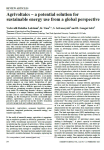Lakshmi V.R., Uma K., Selvanayaki S., Selvi R.G. (2025). Agrivoltaics - a potential solution for sustainable energy use from a global perspective. Current Science, 01/01/2025, vol. 128, n. 4, p. 344-352.
https://doi.org/10.18520/cs/v128/i4/344-352
https://doi.org/10.18520/cs/v128/i4/344-352
| Titre : | Agrivoltaics - a potential solution for sustainable energy use from a global perspective (2025) |
| Auteurs : | V.R. Lakshmi ; K. Uma ; S. Selvanayaki ; R.G. Selvi |
| Type de document : | Article |
| Dans : | Current Science (vol. 128, n. 4, 2025) |
| Article en page(s) : | p. 344-352 |
| Langues : | Anglais |
| Langues du résumé : | Anglais |
| Catégories : |
Catégories principales 16 - TRANSPORT. INFRASTRUCTURE. ENERGIE ; 16.3 - EnergieThésaurus IAMM ENERGIE SOLAIRE ; ENERGIE RENOUVELABLE ; AGRICULTURE |
| Résumé : | Agrivoltaics, the amalgamation of solar panels with farming methods, has been steadily gaining traction as an innovative remedy for managing the conflicting needs of land in both food cultivation and energy generation. This concept emerged in the 1980s and has since gained momentum as a viable solution to optimise land usage for sustainable agriculture and renewable energy production. This integrated production model seeks to synergize food, energy and water resources, offering a sustainable alternative to traditional land division practices. The co-location of solar panels with crops demonstrates promising results, indicating increased agricultural outputs and energy yields. While global leaders like Japan, France, Germany and China have embraced agrivoltaics, challenges in regulatory frameworks and societal acceptance persist, particularly in ed through simulations, highlight promising electrical and agricultural benefits. Comparative assessments against conventional photovoltaic systems reveal potential advantages, including increased electric yield and positive impacts on crop yields. Integration of agrivoltaics into diverse farming practices, from aquaculture to horticulture, offers a holistic approach to sustainable land use, promising secondary income and enhanced crop yields. By addressing farmers' distress, agrivoltaics emerges as a unique solution, providing additional income sources and reducing reliance on traditional farming. As the world pivots towards sustainable agriculture, agrivoltaics presents a beacon of promise, poised to play a pivotal role in the world's transition towards integrated and resilient agriculture. |
| Cote : | En ligne |
| URL / DOI : | https://doi.org/10.18520/cs/v128/i4/344-352 |







